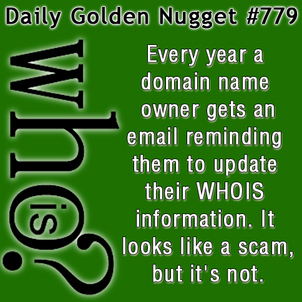 Assuming everything works according to plan, once a year you will receive a scary looking email that looks like a very well planned out phishing email--but it's not...
Assuming everything works according to plan, once a year you will receive a scary looking email that looks like a very well planned out phishing email--but it's not...During the early days of the internet, if you wanted a domain name you had to register it through a company called Network Solutions. Using the trade name InterNIC, they had a monopoly on all domain name registrations until 1998. The early years of the internet were very confusing for domain name owners. There were no control panels and no fancy websites to log into to change settings; in fact you had to use a complicated set of email templates to make changes to your domain.
Ack! Just thinking about this makes my nerves become a little undone.
Although those email templates were a domain nightmare, all website owners understood that they needed to keep their email address up to date and accurate with InterNIC. Otherwise, they would lose control of their domain.
In 1998, several other domain registrars came up with their own methods of controlling domain name ownership. This was the time of the Dot Com internet bubble and millions of new websites were popping up overnight. As the dot com bubble grew and burst, any website that owners suddenly stopped caring about, also didn't care to keep their domain name ownership information up to date. By 2002 the database of domain names was a mess and loaded with orphaned domains because email addresses and phone numbers were being deactivated or disconnected by these website owners.
In 2003, in an attempt to cure the growing problem of orphaned domain name ownership the new organization called ICANN (Internet Corporation for Assigned Names and Numbers) set up a policy to contact all domain name owners every year.
The policy is called the "Whois Data Reminder Policy" or WDRP for short. The idea is that once a year all domain name owners will receive a notice that will make it easy and convenient to update their information. Except the idea has backfired, and the Powers That Be know it.
Imagine this: You receive an email that includes your name, home address, home phone number, email, work address, and work phone number. The email says something simple like "to update any of this information click here." More recent variations of this email don't actually show all your information but the email appears equally suspicious because it says things like "You are getting this email because you are the registered contact. Please review and update your contact information by clicking here."
For most internet users an email like this would look like a scam, but it's not... most of the time.
Here are some details to help you figure out if someone is trying to bait you into clicking a malicious link or if it's that time of year again and you need to verify your domain name information.
Follow these 3 steps:
1. Look carefully at the sender's email address. Does it match the name of the company you actually registered your domain name from? Most email programs now show a person's name instead of their actual email address, so make sure you look at the sender's actual email address. For example, you might get an email from accountupdate@godaddy.com.
2. Look at the links in the email. There should be a clearly readable link for your domain name and a link to update your information. Carefully look at the link preview shown in your browser when you hover over those links. The domain of those links should match the email address. For example: http://dcc.godaddy.com.
3. The email should clearly state that your information needs to be verified according to the "Whois Data Reminder Policy" and it should give you a link to read the policy on the icann.org website.
Assuming everything looks good, you can click those links and follow the directions to verify your information.
If the idea of this domain verification email makes you nervous then I suggest that you forward it to your web programmer for them to take care of it for you. If its legit, there is no information in that email that your programmer doesn't already know. If its a scam, they'll know immediately.
Be safe out there!








